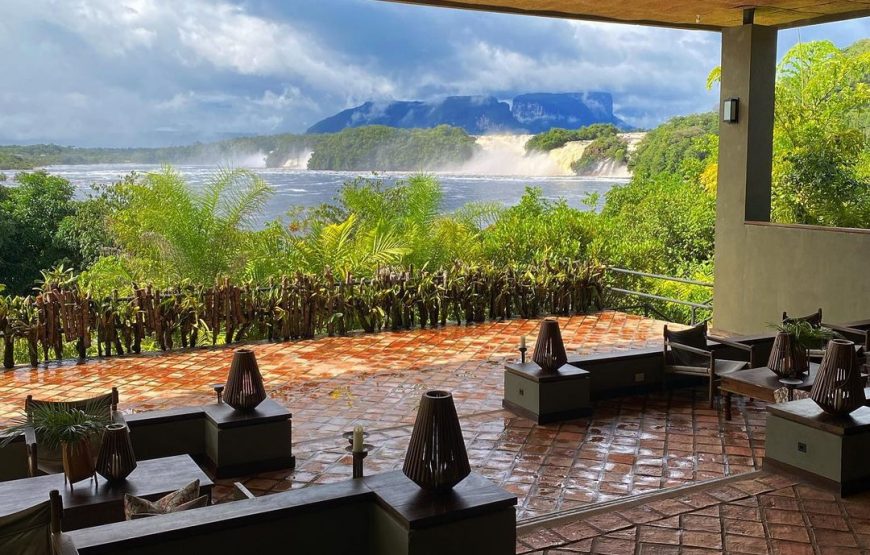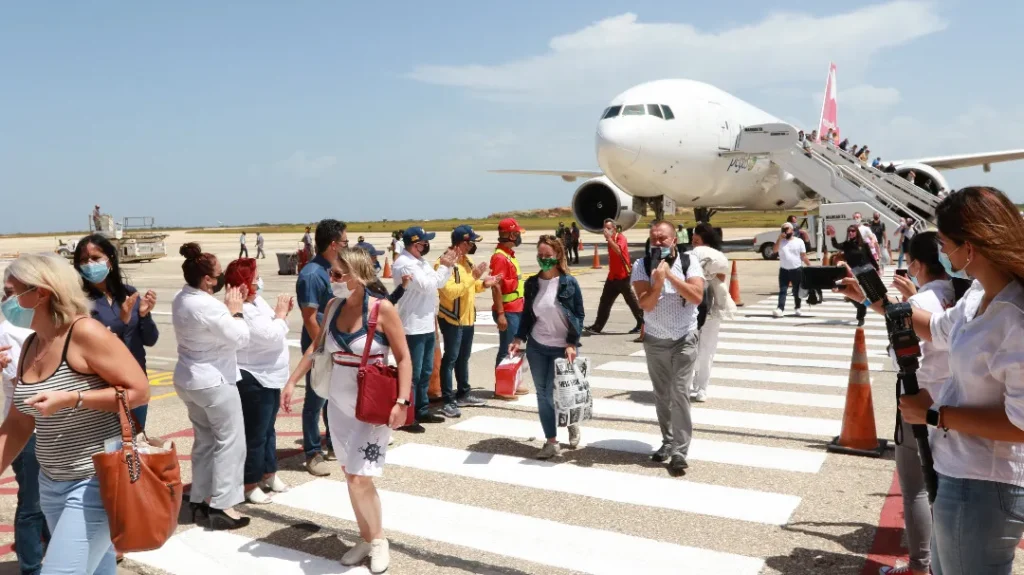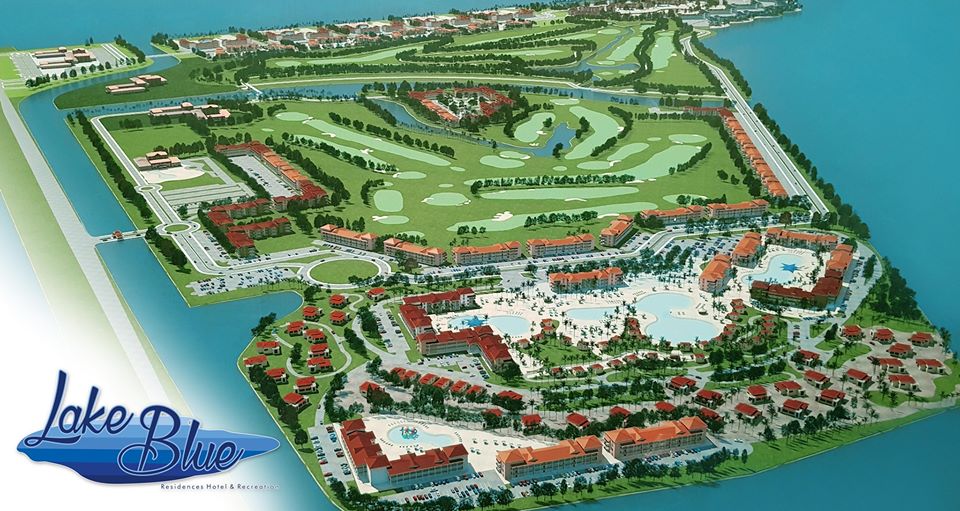How International Tourism Is Trickling Back to Venezuela
After a prolonged drought of international tourism in Venezuela, there are signs that the industry is slowly recovering.


When almost 300 Polish tourists arrived at Margarita’s airport recently, they were greeted with smiles and welcome drinks, presented with hats, and snapped by cameras. Since November, when a charter flight agreement between Venezuela and Poland began, there’s been a stream of pictures and videos published online by government officials and news sites showing the latest arrivals and highlighting the increase in visitors.
Both the government –and those working within the tourism industry– say the number of international tourists has been rising. In 2023, 1.25 million foreign visitors came to Venezuela, according to Venezuela’s tourism ministry – an increase of 90% on the year before when 656,000 people reportedly arrived. While it’s difficult to verify the figures, there have been a number of tourism agreements between Venezuela and other countries since 2021, helping with the swell in arrivals.
“There is ongoing work with Poland, Russia, Colombia and other countries with a significant number of charter and scheduled operations,” Vicky Herrera, President of the Venezuelan Association of Travel Agencies (AVAVIT,) told Caracas Chronicles. Venezuela’s tourism sector doesn’t have its own figures for the number of international tourists visiting the country, meaning it’s difficult to confirm or deny the government’s tourism statistics, according to Herrera. But she said that there has been a notable increase in foreign tourists, particularly in 2023. “Tourists started to return, firstly out of curiosity, then later with more conviction that Venezuela was a great destination.”
Flight connections have also increased in the last three years. Besides direct flights between Russia and Margarita, direct flights with Colombia –through a series of different airliners, including Wingo and Avianca– and Portugal have returned. There are also new routes to Istanbul and San José in Costa Rica. Similarly, hotels and posadas have revived their activities in Caracas and elsewhere. There are new ones throughout Canaima, Morrocoy, Margarita, Mochima and Los Roques; a new Eurobuilding was inaugurated in Lechería while a British company is renovating the Ambassador Suites in Caracas.
And it’s not only those wanting package tours that are booking trips. After years of stagnation, interest –and reservations– from backpackers and independent travelers has also gone up. “We’re very busy until June,” Jose Manuel Silva, a mountain guide and head of sustainable travel company, Venezuela Verde, said. His business offers a variety of tours to destinations within the country such as Canaima, Roraima and the Amazonian rainforest, and the number of international tourists booking tours with him shot up in 2023, compared to previous years. “It was very quick,” he said referring to the rise. “We have been full of foreign tourists. Koreans, Australians, Germans, Russians, North Americans…” For him, and others within the tourism realm, it’s a welcome sign after years of inertia.

Venezuela once enjoyed a prosperous and relatively healthy tourism sector. Famed for its palm-fringed and white sand beaches, the tallest waterfall in the world, and the mountains of the Venezuelan Andes, the country generated well over a billion dollars from the tourism industry in 2008, according to data from The World Tourism Organization. International tourists were abundant. “For years we had a lot of tourism from different countries,” José Lobo, an independent tour guide and driver in Mérida said, remembering more prosperous times when Venezuela’s tourism industry was in a healthier state. “But then this disappeared. People didn’t come anymore.”
Before Covid-19 brought global tourism to a halt, Venezuela’s tourism sector had already suffered a catastrophic plunge. From one millon visitors in 2013, international arrivals began on a downward trend, dropping to 429,000 in 2017 due to political instability, sky-high inflation, tales of kidnappings and a surge in violent crime. Those within the industry –like many others– saw their incomes vanish and their quality of life begin to suffer. Today, international tourism in Mérida, and in Venezuela as a whole, is still a little lethargic, but Lobo believes it’s starting to wake up. “It’s recovering a little,” the 75-year-old says. “I had a Portuguese client last week and I’ve had other foreign tourists recently too.”
For a long time, high crime rates put tourists off coming to the country. According to the Venezuelan Observatory of Violence, there were 91.8 violent deaths per 100,000 inhabitants in 2016 – the second highest in the world at the time after El Salvador. But seven years later, Venezuela recorded a 70 percent drop, with 26.8 violent deaths per 100,000 people in 2023.
“I think that many foreigners got carried away by the news,” Silva, from Venezuela Verde, noted, adding that some potential tourists contacting his company still do have concerns over safety. “Much of people’s insecurity comes from the news and governments showing that Venezuela is ruined. The murder rate they take to show all of Venezuela. There are some dangerous areas but not all of Venezuela is like that.”
The perception is slowly changing, he says, partly due to social media and influencers, which are helping to bring back visitors. “The influencers that have come have shown the best of our country and the fear has dropped at an international level,” Silva said. The Minister of Tourism, Alí Padrón, recently announced that 140 influencers from over 20 countries visited Venezuela in 2023, captivated by its nature, food and people – and that they were transforming the image of the country. Among these, the visits of Mexican vloggers Luisito Comunica and Alex Tienda stand out. A British traveler, Patrick Ohlenschlager, has also been touring every state in the country and documenting it on his Instagram.
Aside from content on Instagram and TikTok, word-of-mouth in travel, backpacker and social media groups have informally changed the narrative of the security situation and challenges tourists might encounter. “The increase is because of the good comments in Facebook groups from people who have been,” Peter Moens, a posada owner, told Caracas Chronicles. Originally from Belgium, he opened a Iguana Garden posada in Valencia in 2022 with his Venezuelan wife. They’ve had a steady increase of foreigners, and seen a notable change in perception of the security situation in online groups. “What is remarkable is that when in 2022 somebody said in a group that he wanted to go to Venezuela, people would tell them they were crazy and that they would get robbed and even killed from the moment they came in,” he said. “Now when somebody asks in the group about safety, reactions are more positive.”
The government has said it wants to improve the tourism industry and see international visitor numbers increase by another 300,000 in 2024. “One of the lungs of the economy must be tourism and we are working to make that happen,” Minister Padrón said recently. Venezuela now has a number of tourism agreements in place, like the one with Poland – which has brought around six and a half thousand Poles to Margarita since November.

Tourism relations have also strengthened with Russia. When Moscow invaded Ukraine in 2021, Russians faced difficulties in obtaining visas for many countries. Yet, Venezuela opened direct flights between Margarita island and Russian cities. In 2023, more than 30,000 Russians arrived in Venezuela, according to the Ministry of Tourism. Furthermore, a number of international airlines have started operating flights again to Caracas – or increasing the small number of flights that were already on offer. In fact, in January of 2023, Margarita island received its first European cruise liner in 15 years. 500 tourists, many of them German, returned to an island that is now accustomed to Russian tourists.
Despite a positive turn for the tourism sphere, challenges remain. The security situation has improved, but corruption remains an ongoing issue. “It’s much safer, but there is still the police. This makes it difficult around the border,” posada owner Moens said, referring to problems independent tourists have on entering land borders and getting asked for money or valuables at police checkpoints. “The Ministry of Tourism needs to take care of this, because this is the worst reputation for Venezuela.” Furthermore, compared to its South American neighbors, Venezuela is expensive, and accessing money itself is often riddled with hurdles. ATMs often don’t accept foreign cards, and even though some tour companies and hotels have reopened, many only accept cash or PagoMovil.
There are also concerns that aspects of the tourism drive by the government and some private companies are already leading to damaging situations for the environment and for communities. In Los Roques, while authorities concentrate on the expansion of the runway on Gran Roque to attract more tourists, residents have complained of a failure of basic services, often with electricity cut for hours each day. On top of that are worries over environmental destruction of both the runway and development projects using heavy machinery and allegedly using nearby stone and earth for the runway, threatening mangroves, coral and wildlife.

Similar criticisms have been directed at large construction projects ordered by the government in Morrocoy National Park that threaten the habitats of sea turtles in the area. Similarly, it’s expected that a huge resort named Lake Blue –partially owned by Spanish hospitality company Hesperia– will destroy fragile mangroves to open up a canal while the new government-promoted touristic mega-projects of the new La Tortuga Special Economic Zone could affect local ecosystems.
Yet despite obstacles and important challenges, international tourism in Venezuela is no longer dormant, and those within the tourism sector are hoping the coming months translates into more arrivals and bookings from overseas visitors. “We hope to have a greater participation of tourists in Venezuela, a greater number of nationalities, greater connectivity so that they can arrive more easily, and of course greater economic and political stability,” Herrera said, echoing what others across the sector are saying.
At his posada in Valencia, Peter Moens said that Venezuela has a lot to offer visitors. Aside from the country’s natural beauty, he believes that what people like most about Venezuela are the Venezuelans, the hospitality, and the friendliness. “Everyone who has come here has been very positive and wants to come back,” Moens said, cautiously optimistic that the darkest days of Venezuela’s tourism industry are now firmly in the past.
Caracas Chronicles is 100% reader-supported.
We’ve been able to hang on for 22 years in one of the craziest media landscapes in the world. We’ve seen different media outlets in Venezuela (and abroad) closing shop, something we’re looking to avoid at all costs. Your collaboration goes a long way in helping us weather the storm.
Donate




